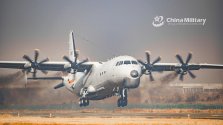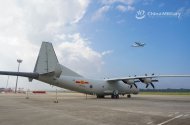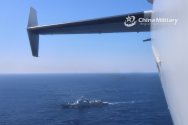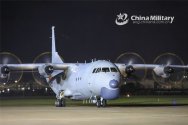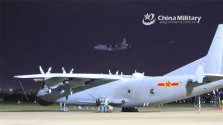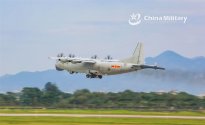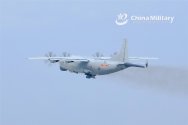You are using an out of date browser. It may not display this or other websites correctly.
You should upgrade or use an alternative browser.
You should upgrade or use an alternative browser.
PLAN ASW Capability
- Thread starter shen
- Start date
Typo, should be Z-20.PLAN Ka-28 being retired, after 2 decades of service, being replaced by Z-10.
Will the AEW variant also be retired?Typo, should be Z-20.
Hendrik_2000
Lieutenant General
Introducing Dolphin apparently further development of Haiyan series glider that has been in service with Chinese oceanographic service of PLAN But this improved model is more directed toward ASW since it is equipped with propeller, miniature sensor to detect submarine. Not sure if it operational yet but reading this article they have tested and improve the system for swarm operation and add artificial intelligence. Should be close to operational
The Dolphin is based on the glider developed by researchers at Tianjin University. Like most sea gliders, the Haiyan is a tubular robot with wings and a visible antenna. However, it is somewhat unusual in that it is equipped with a small propeller, if needed to surface quickly in the event of a potential submarine contact. Chinese oceanographers have already deployed Haiyan gliders within the first island chain and beyond. A specially designed Haiyan variant () is capable of diving to tremendous depths, including the . Another variant () has been built for greater endurance, purportedly up to five months of continuous operations.
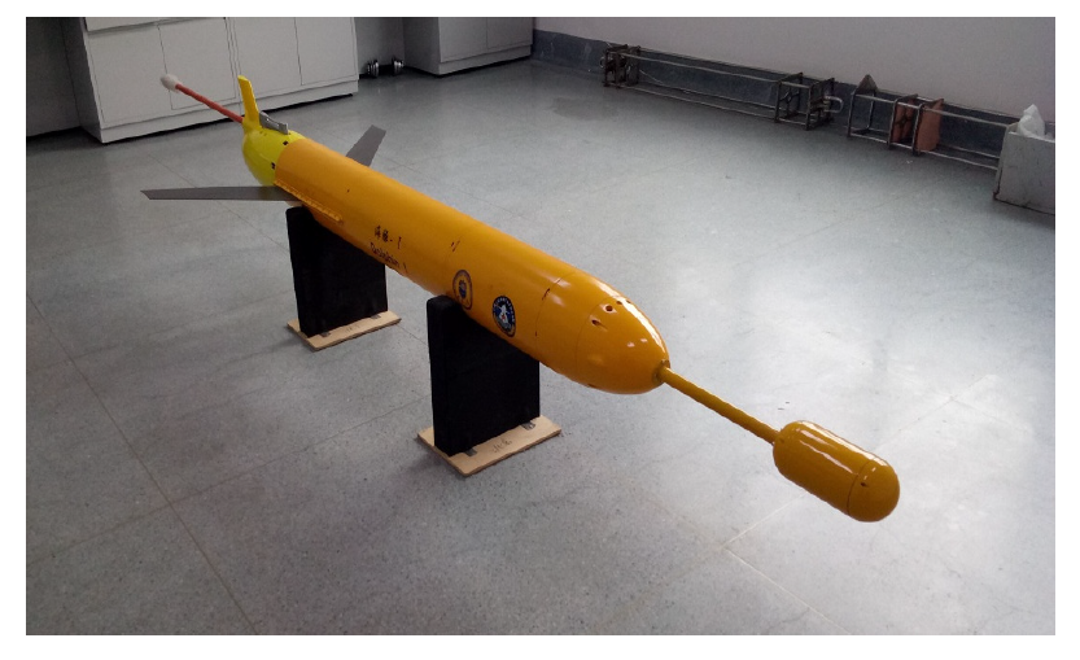 The Dolphin Acoustic Glider (Source: )
The Dolphin Acoustic Glider (Source: )
The Dolphin a typical Haiyan glider, except for a vector sensor protruding from its nose. Within the body of the glider, forward of the batteries, is its . indicating that the platform is designed to autonomously detect, classify, and locate undersea targets, not merely to record and transmit raw data for interpretation elsewhere.
The Dolphin project is led by the (海军水下作战环境研究所) at the PLAN Submarine Academy. It is by the Institute’s Director, Rear Admiral Da Lianglong, perhaps the PLAN’s expert on undersea science and technology. Rear Admiral Da has won numerous national, provincial, and military for his work on how the undersea environment affects sonar performance and submarine tactics.
Under Rear Admiral Da’s leadership, the Environmental Research Institute has shrewdly leveraged civilian organizations to help advance its mission. In 2013, his institute turned its attention to . Then, in 2016, it joined with the Qingdao Pilot National Lab for Marine Science and Technology to create the in Qingdao, with Rear Admiral Da as its director. This allows the Submarine Academy to benefit from the expertise, access, and resources available to the civilian marine science community. When Xi Jinping visited the Qingdao Pilot National Lab in June 2018, he about the importance of civil-military integration in marine science. Rear Admiral Da in the audience, the embodiment of Xi’s ideal.
Milestones
The team at the Submarine Academy overcame several technical challenges to make the Dolphin a viable ASW platform including self-noise, contact localization fidelity, and overcoming the immense pressure water pressure of deep dives.
The first was self-noise. Researchers originally built the Haiyan glider for oceanographic research, where self-noise is far less of a concern. However, when detecting submarines, it is vital that an ASW platform be as quiet as possible to make it easier to distinguish the relevant signatures from other noises and thereby maximizing the signal to noise ratio. This is especially important when that signature is extremely faint, like those emitted by modern submarines.
The Haiyan produces noise at the bottom of its dive, when a pump activates to increase buoyancy needed for the ascent. It also produces noise when the propeller engages. These noise problems, however, are simple fixes since the glider can be programmed to turn off its vector sensor during the brief periods when the pump and propeller are on. For the Chinese researchers, the real challenge was reducing the noise generated by the mechanisms used to maintain the glider’s course and attitude. Researched overcame this challenge by changing the position of the glider’s internal battery packs. Through conducted at first in specially designed pools followed later by tests in the South China Sea, the researchers were able to attitude and course adjustment mechanisms to reduce this self-noise.
Finally, Chinese scientists also had to develop a vector sensor that could reliably operate in the high-pressure environment of the deep ocean. Since many countries prohibit the sale of acoustic sensors to China, researchers could not simply import a foreign product. Since the early 2000s, experts at Harbin Engineering University have conducted on vector sensors. The team at the Submarine Academy built off their work to develop a deep water vector sensor. In 2019, researchers the new sensor in the South China Sea at depths of 800 meters and 1,200 meters with promising results. That same year, Rear Admiral Da and several other colleagues at the Submarine Academy patented a vector sensor that could effectively operate down to 4,000 meters. According to their , the sensor could be particularly suited for unmanned platforms like gliders “for use in submarine detection.”
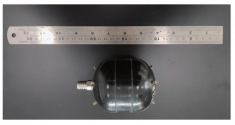
The Dolphin is based on the glider developed by researchers at Tianjin University. Like most sea gliders, the Haiyan is a tubular robot with wings and a visible antenna. However, it is somewhat unusual in that it is equipped with a small propeller, if needed to surface quickly in the event of a potential submarine contact. Chinese oceanographers have already deployed Haiyan gliders within the first island chain and beyond. A specially designed Haiyan variant () is capable of diving to tremendous depths, including the . Another variant () has been built for greater endurance, purportedly up to five months of continuous operations.

The Dolphin a typical Haiyan glider, except for a vector sensor protruding from its nose. Within the body of the glider, forward of the batteries, is its . indicating that the platform is designed to autonomously detect, classify, and locate undersea targets, not merely to record and transmit raw data for interpretation elsewhere.
The Dolphin project is led by the (海军水下作战环境研究所) at the PLAN Submarine Academy. It is by the Institute’s Director, Rear Admiral Da Lianglong, perhaps the PLAN’s expert on undersea science and technology. Rear Admiral Da has won numerous national, provincial, and military for his work on how the undersea environment affects sonar performance and submarine tactics.
Under Rear Admiral Da’s leadership, the Environmental Research Institute has shrewdly leveraged civilian organizations to help advance its mission. In 2013, his institute turned its attention to . Then, in 2016, it joined with the Qingdao Pilot National Lab for Marine Science and Technology to create the in Qingdao, with Rear Admiral Da as its director. This allows the Submarine Academy to benefit from the expertise, access, and resources available to the civilian marine science community. When Xi Jinping visited the Qingdao Pilot National Lab in June 2018, he about the importance of civil-military integration in marine science. Rear Admiral Da in the audience, the embodiment of Xi’s ideal.
Milestones
The team at the Submarine Academy overcame several technical challenges to make the Dolphin a viable ASW platform including self-noise, contact localization fidelity, and overcoming the immense pressure water pressure of deep dives.
The first was self-noise. Researchers originally built the Haiyan glider for oceanographic research, where self-noise is far less of a concern. However, when detecting submarines, it is vital that an ASW platform be as quiet as possible to make it easier to distinguish the relevant signatures from other noises and thereby maximizing the signal to noise ratio. This is especially important when that signature is extremely faint, like those emitted by modern submarines.
The Haiyan produces noise at the bottom of its dive, when a pump activates to increase buoyancy needed for the ascent. It also produces noise when the propeller engages. These noise problems, however, are simple fixes since the glider can be programmed to turn off its vector sensor during the brief periods when the pump and propeller are on. For the Chinese researchers, the real challenge was reducing the noise generated by the mechanisms used to maintain the glider’s course and attitude. Researched overcame this challenge by changing the position of the glider’s internal battery packs. Through conducted at first in specially designed pools followed later by tests in the South China Sea, the researchers were able to attitude and course adjustment mechanisms to reduce this self-noise.
Finally, Chinese scientists also had to develop a vector sensor that could reliably operate in the high-pressure environment of the deep ocean. Since many countries prohibit the sale of acoustic sensors to China, researchers could not simply import a foreign product. Since the early 2000s, experts at Harbin Engineering University have conducted on vector sensors. The team at the Submarine Academy built off their work to develop a deep water vector sensor. In 2019, researchers the new sensor in the South China Sea at depths of 800 meters and 1,200 meters with promising results. That same year, Rear Admiral Da and several other colleagues at the Submarine Academy patented a vector sensor that could effectively operate down to 4,000 meters. According to their , the sensor could be particularly suited for unmanned platforms like gliders “for use in submarine detection.”

A Y-8 anti-submarine warfare aircraft of the Chinese People's Liberation Army (PLA) reportedly conducted a maritime patrol mission near the island of Taiwan on Tuesday, two months since this type of aircraft last appeared in the region, amid speculation that an aircraft of this type had an accident in March.
The alleged accident has not been confirmed, but in any case, the Y-8 anti-submarine warfare aircraft is now well prepared to carry out missions, at a time when external forces have been provocatively sending warships and submarines to the Taiwan Straits and the South China Sea, analysts said on Wednesday.
One PLA Y-8 anti-submarine warfare aircraft entered Taiwan's self-proclaimed southwest air defense identification zone on Tuesday, flying between the island of Taiwan and the Taiwan-administered Dongsha Islands in the South China Sea, according to a press release by Taiwan's defense authority on the day.
This seems to be the first time a Y-8 anti-submarine warfare aircraft has been reported by the island's defense authority since March 1, observers said. The PLA instead deployed vessel-based anti-submarine warfare helicopters like the Z-9 and the Ka-28 over the past two months, according to the island's defense authority.
Citing Taiwan's intelligence agency, overseas media claimed in March that a Y-8 anti-submarine warfare aircraft had an accident in the South China Sea in that month, leading some analysts to speculate that the PLA suspended flights of this type of aircraft to conduct investigations and clear up potential problems.
The PLA has not made any comment on the speculation over the alleged accident.
An aviation regiment attached to the PLA Southern Theater Command Navy organized flight training for the Y-8 anti-submarine warfare aircraft on April 26, the PLA Daily reported on Saturday. This is another sign that the aircraft is indeed active, observers said.
At a time when external forces have been frequently sending spy planes to conduct close-in reconnaissance near the Chinese mainland, dispatching warships to provocatively sail through the Taiwan Straits, and deploying submarines to the South China Sea, it is necessary for the PLA to enhance its capabilities and preparedness to monitor and patrol relevant regions with not only anti-submarine warfare helicopters, but also fixed-wing aircraft, as the latter can cover a larger area in a shorter time, Fu Qianshao, a Chinese mainland military aviation expert, told the Global Times on Wednesday.
The PLA is commissioning more Y-8 anti-submarine warfare aircraft, and patrols and drills by this type of aircraft have become routine, Fu said. The expert expected more of them to appear near the island of Taiwan in the future.
Does SSBN's actually use SSN as escorts in reality? It seems dangerous since you have very little coordination with the other submarine unless you expose yourself by going to periscope depth. The whole idea of a SSBN is to be undetected so I don't quite get the SSN "Guard" role.SSBN escort
It’s also my question.Does SSBN's actually use SSN as escorts in reality? It seems dangerous since you have very little coordination with the other submarine unless you expose yourself by going to periscope depth. The whole idea of a SSBN is to be undetected so I don't quite get the SSN "Guard" role.
Floating raft, airbag etc. now it’s a little bit out of date since active isolation systems have been very popular(active system also needs airbags etc. but would be much smaller)What do you mean exactly by passive noise isolation technology?
Last edited:


